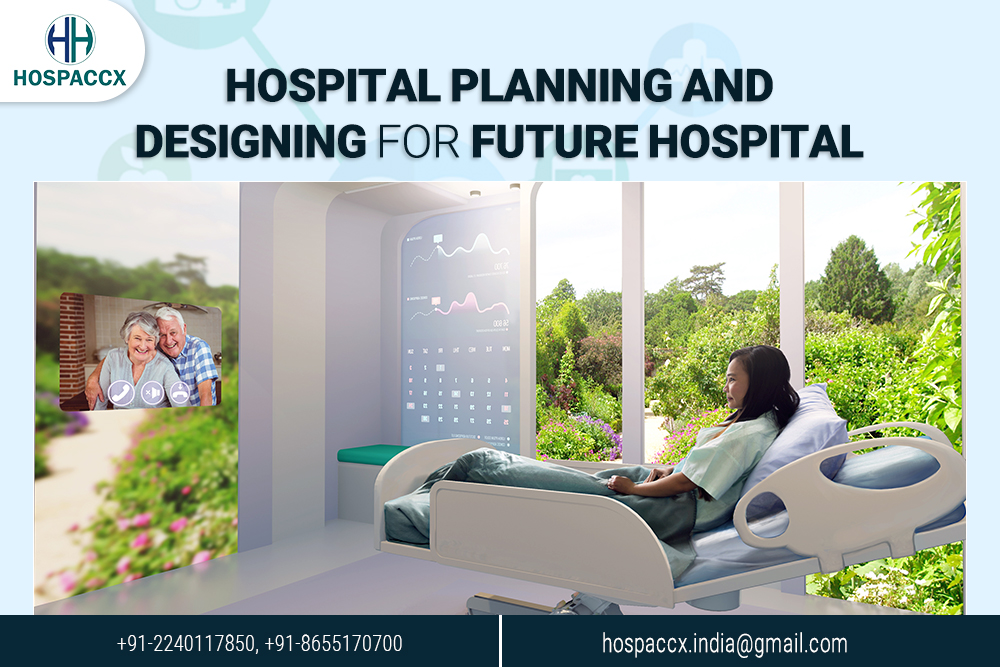INTRODUCTION
The future hospital is a resilient, physical learning facility featuring digital enhancement and leveraging an ecosystem of platforms for the Internet of Things and analytics, achieving patient-centric care delivery via multidisciplinary healthcare provider teams coordinated to meet patients’ medical, psychological, social and economic needs.
Considering the above facts, Hospaccx team contributes on the market trends and dynamic regarding future hospital planning and designing. This is macroficial study of Hospital Planning and Designing for Future Hospital if you want to get into more detail you can contact info@hhbc.in
THE FUTURE HOSPITAL: A LOGICAL PLANNING APPROACH
A hospital by definition is all about people and movement, planning has to start with circulation systems as a basic framework for any concept:
- The main public entrance needs high visibility and easy access, leading to the main public space.
- An outpatient entrance, also visible but separate from inpatient and visitor traffic, leads to ambulatory care clinics.
- Emergency Medicine needs a separate away from public traffic, but convenient to outside access.
- The service entrance and loading bays need to be easily accessible but out of public view.
- Drop off and parking needs to be conveniently provided for all types of traffic.
- Hospital staff parking, separate from patients, needs to be close to a 24 hour entry.
As each of these layers of circulation is added to the plan, the logical form of the hospital begins to take shape, with different types of traffic approaching from different directions and vertical circulation finding its place as logical nodes along the circulation grid.
FOUR POINTS FOR DESIGNING THE HOSPITAL OF THE FUTURE
- Take Time to Develop the Value Proposition
The value proposition is an idea, couched in broad-based, independent accreditation of a concept. When executed, it should provide positive improvements for patients, caregivers, and operations, while also keeping the facility’s return on investment in mind.
- Do the Research
It is a process that enables design researchers to identify a specific research question and then search for, select, appraise, summarize, and combine scientific evidence and project parameters to address the research question. This exercise worked to dispel opinions, and confirmed best practices and theories that ultimately helped to guide the design.
- Utilize Patient Advocacy Surveys
Using an online questionnaire, asking a random set to hundreds of patients to assess inpatient unit footwall renderings and furnishings. When combined with scientific evidence, the results of these patient advocacy surveys will enable to refine the design goals and focus on creating spaces that ultimately improve the patient experience.
- Conduct Post-Occupancy Evaluations
A self-report questionnaires could administer to patients and providers as a way to conduct a post-occupancy evaluation and see the true impact of our design.
FUTURE OF HOSPITAL INFRASTRUCTURE IN INDIA
With a population of 1.2 billion, and growing by almost 18 million per year, India will be the most populous nation by 2030, with as many as 1.4 billion or more inhabitants. Indian civic infrastructure, however, has not developed at the same pace and is not strong enough to cater to the nation’s growing needs. While many aspects contribute towards this deficit, a primary factor is the time and cost taken to build and deliver competent infrastructure facilities.
In India, the main challenges of healthcare development are the costs involved in the building and upgrade of healthcare infrastructure, the disruption caused by conventional construction methods, the lack of transparency, corruption and a generally chaotic development environment. Upgrading of healthcare infrastructure has tremendous pay-offs in the long-term and investments in this sector are crucial. Revamping India’s healthcare facilities will not only raise the quality of life for all but will also make the healthcare industry in India, a key enabler for economic growth.
It is imperative to explore newer alternatives to bridge the critical gaps in infrastructure, especially with respect to the availability of healthcare centres. The best way to deliver international standard healthcare, for superior patient experience and treatment is to employ patient-centric design and supplement it with off-site building technology to ensure a fast and reliable solution. This model is the only practical way to meet the healthcare needs of India’s fast-growing population.
Off-site construction is the process of planning, designing, fabricating, transporting and assembling building elements at a factory rather than at the construction site. It cuts the delivery time by 50% and reduces cost up to 30% while producing high quality and custom built buildings.
While off-site manufacturing in healthcare is still new in India, it is widely used in western markets. It is a tried and tested method that best suits the needs of the Indian market. The international design concept for healthcare facilities puts the patient experience at the core of development, taking into account aspects such as accessibility and floor to space ratio.
Some large-scale private super speciality hospitals when opting for new projects and redesign have implemented off-site manufacturing of the entire structure and interiors. The chief advantages of this process are better standardization and industrialization allowing rapid scaling up, and commoditization leading to cost benefits in delivery, maintenance, operations and sustainability of the healthcare facilities.
The Indian government has also taken steps to make medical travel to the country easier by streamlining and offering e-services for visa processes. India can become a leading medical tourism destination if it can manage the healthcare infrastructure gap it is facing and attract tourists from world-wide.
India’s healthcare sector is on the cusp of rapid growth, rising income level, greater health awareness and improved access to insurance are the key contributors. The private sector has emerged as a vibrant force in India’s healthcare industry, lending it both national and international repute and it accounts for almost 74% of the country’s total healthcare expenditure. Further, the presence of world-class hospitals and skilled medical professionals has strengthened India’s position as a preferred destination for medical tourism.
Off-site manufacturing and modular construction in healthcare will be a significant catalyst to the sector’s success. It will be the cornerstone on which India builds its position as a leading player in the global healthcare market.
CONCLUSION
The future hospital is not about the physical structure/technology; it is about building staff competency, creating an ecosystem that consists of platforms for patient engagement, staff talent management and delivering high quality, safe, efficient and effective care. It is about employing innovative new methods to re-invent the care processes to serve the patient population.
Are you planning to design your healthcare organisation? We can help you to design your dream project, below are the healthcare design services that we offer:-
- Healthcare Architecture Design services
- MEP Design
- Landscape Design services
- Structural Design services
- Interior Design services
It is the superficial and macro level study for more details kindly contact Hospaccx Healthcare business consulting Pvt. ltd on hospaccx.india@gmail.com Or you can visit our website on https://hospaccxconsulting.com/
Related Team Members




















